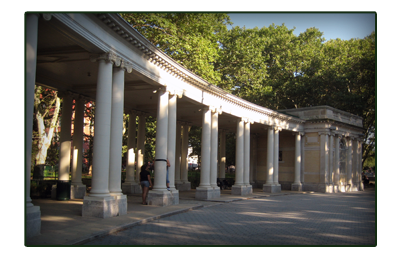


Winthrop Jones Park : A Brief History
The land for the park was acquired by the city in 1889 and the park was open by 1891. It was originally called Winthrop Park after an assemblyman, Col. Winthrop Jones, who was instrumental in obtaining the $132,825 appropriation for the purchase, and who was also the son of the Parks Commissioner. He died in 1890, shortly after the Park's creation. According to the Brooklyn Daily Eagle, Jones was a Maine native and co-owned a lumberyard at the corner of Kent and West Streets. In 1941 the park was renamed for Monsignor Edward J. McGolrick (1857-1938), pastor of St. Cecilia's Roman Catholic Church nearby. Winthrop Jones had had no children, and so left no family in Greenpoint to oppose the renaming of the park he had helped establish.

Prominent features of the park include the classical Shelter Pavilion (1910), which was designated a New York City landmark in 1966, and a monument (1938) to the USS Monitor ironclad ship.
West of the pavilion stands a bronze winged victory figure created by Carl Augustus Heber (1875–1956) in 1923. The monument honors those residents of Greenpoint, Brooklyn who fought in World War I. The statue depicts a female allegorical figure, holding aloft a modified laurel, a symbol of victory, and in her right hand supporting a large palm frond, a symbol of peace. The granite pedestal is inscribed with the names of battle sites in France. The monument was commissioned at a cost of $7,300 by the Greenpoint Memorial Association.
The park is featured in Episode 8 of the HBO Series Flight of the Conchords as the scene of a musical montage.
-wikipedia







